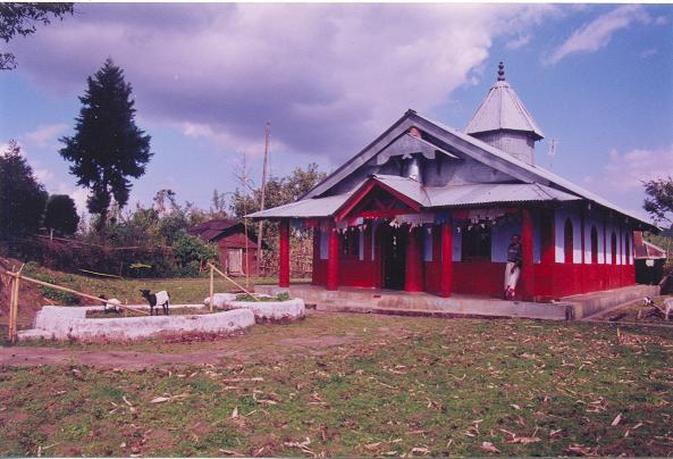Jayantia Shaktipith, located at Kalajore Baurbhag village of Falzur Pargana under Jayantia Thana of Sylhet district, Bangladesh. The temple is situated along Jaynati River. It is also known as Falizur Kalibari. Here in, Goddess Shakti is worshipped as Jaynatia and lord Shiva as Karamadeeswar
According to Hindu Scripture Left Thigh of Sati had fallen here.These are the places that are believed to have enshrined with the
presence of Shakti due to the falling of body parts of the corpse of
Sati Devi, when Lord Shiva carried it and wandered throughout the
universe in sorrow.
Each temple has shrines for Shakti and Kalabhairava
and mostly the each temple associates different names to Shakti and
Kalabhairava in that temple.The art and architecture of the temple is simple, but splendid. The temple is engraved in a hill and is surrounded by mountains, forests and rivers.
The temple dome is covered with gold plated sheet. The temple has a large courtyard. There are three caves around the temple. The first cave has the idols of the holy Trinity- Lord Brahma, Vishnu and Ishwar. The second cave has the idol of Lord Shiva and the third cave has the idol of goddess Mahakali.
Maa Jayanti Shaktipeeth is located in Falzur Pargana, Bangladesh.This Shaktipeeth is located at Baurbhaga village near Jayantiya hill which is 35 km away from shilling. The left thigh of Sati is said to have fallen here.
Devi is known as Jayanti and Lord Shiva is called as Kramdishwar. The temple is constructed at the foot of Jayantiya Hill. The old name of this place was Bamur which is named as left thigh was said to have fallen here.
Now this place is called Baurgram. This place is called as Maa Jayanti Shaktipeeth. Darshan of this Shaktipeeth purifies one's character.Jayantia Shakthi Peeth is the place where the left thigh of Devi Sati fell. Here Devi Sati is worshipped as Jayanti and Lord Shiva as Kramadishwar. Jayantia Shakth Peeth is locally known as Falizur Kalibari.
According to the Hindu Scripture the mythology of Daksha yajna and Sati's self immolation had played a significant role in shaping the ancient Sanskrit literature and even had impact on the culture of India. It led to the development of the concept of Shakti Peethas and there by strengthening Shaktism.
Various mythological stories of puranas made the Daksha yajna as the reason for its origin. It is an important incident in Shaivism resulting in the emergence of Parvati in the place of Sati Devi and making Shiva a Grihastashrami (house holder) leading to the origin of Ganapathy and Subramanian.
Do:
- Do pray your Ishta Devata before pilgrimage to Temple.
- Do contact Temple Devasthanam information centre for enquiry, temple information and for Pooja details etc.
- Do reserve your travel and accommodation at Temple well in advance.
- Do bath and wear clean clothes before you enter the temple.
- Do concentrate on God and Goddess inside the temple.
- Do maintain silence and recite your Istamantram to yourself inside the temple.
- Do observe ancient custom and traditions while in Temple.
- Do respect religious sentiments at Temple.
- Do deposit your offerings in the hundi only.
Don't s:
- Do not come to Temple for any purpose other than worshipping of God and Goddess.
- Do not smoke at Temple.
- Do not consume alcoholic drinks at Temple.
- Do not eat non-vegetarian food in the Kshetram.
- Do not approach mediators for quick Darshanam. It may cause inconvenient to others.Do not carry any weapon inside the temple.
- Do not wear any head guards like helmets, caps, turbans and hats inside the temple premises.
- Do not perform Sastanga Pranama inside the Sanctum Sanctorum.
- Do not take much time while performing Sparsa Darshanam to God in Garbhagriha.
- Do not buy spurious prasadams from street vendors.
- Do not encourage beggars at Temple.
- Do not spit or create nuisance in the premises of the temple.
